What is Šaltibarščiai?
Šaltibarščiai (Cold Beet Soup) is a Lithuanian recipe that typically of cold roasted beets, cucumbers, and kefir. It is served cold with a sliced boiled eggs on top, and optional dill and chives for garnishing! If the sound of these ingredients are appealing to you, you might want to check out other refreshing recipes such as cucumber salad with yogurt dressing, or a refreshing watermelon drink.
What are the steps on how to make Šaltibarščiai?
Step 1: Get the ingredients
To make Šaltibarščiai, you will need some already cooked beets (or roast them yourself and then cool it), mix them with kefir, and serve with boiled eggs. For this recipe, we are going to use a combination of Greek yogurt and buttermilk since we couldn’t find any kefir. If your local grocery store sells kefir, you can use that instead.
- 2 medium sized beets, boiled and cooked (try to retain as much of the beet juice as you can)
- 2 medium-size gerkin pickles, grated
- 2 Persian cucumbers, grated
- 2 eggs, hard-boiled, slices
- 1 cup Greek yogurt
- 2 cups buttermilk
- 1 handful fresh dill, finely chopped
- 1 handful fresh chives, finely chopped
- 6 stalks spring onions, finely chopped
- Juice of ½ lemon
- Salt and pepper to taste
Step 2: Roast the beets (if you bought precooked ones, skip to step 3)
If you’re using beets from your garden or bought raw beets from the grocery stores, you can roast them and then cool. We use already cooked ones because it cuts down on the prep time significantly.
To roast the beets, cut off their leafy tops (save the greens for other delicious recipes!). Scrub gently and rinse thoroughly. Wrap in aluminum foil and drizzle gently with some olive oil. Roast for 45 minutes in the oven at 400 degrees.
Small beets can be in the same aluminum foil, but if you have large ones, I’d do them individually.
Let cool before proceeding with this cold beet soup recipe.
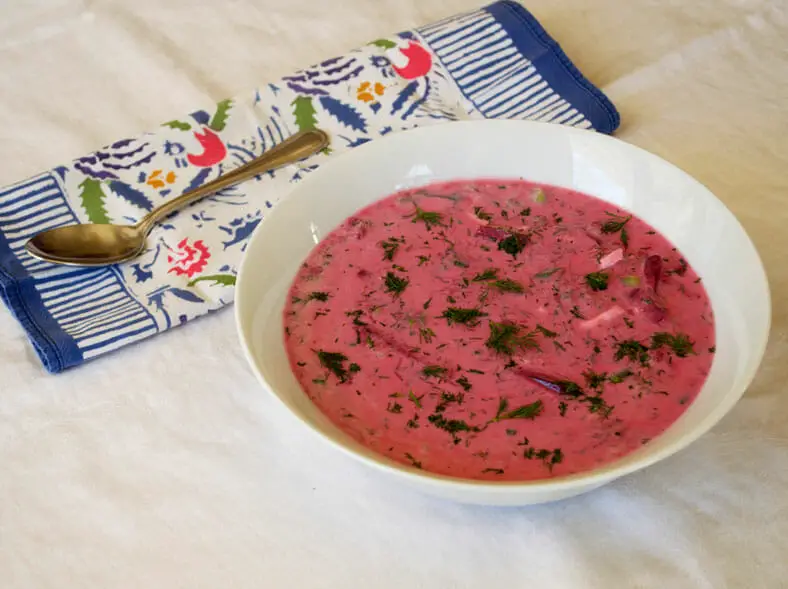
Step 3: Grate the beets, cucumbers, and pickles
Start making your beet soup by grating both your cucumbers and pickles into your bowl. Next, grate your beets into the same bowl, then add crumbled pieces of hard boiled egg in as well.
Pour in your Greek yogurt and buttermilk into the bowl, and mix all your ingredients well. The yogurt should begin to take on the purple hue of the beets
Add your dill, chives and spring onions. While gradually pouring in your lemon juice, mix all the ingredients in your saltibarsciai well
Step 4: Let chill and serve
Place in the fridge for at least 20 minutes to cool down, although the flavors will meld nicely if you let it cool for longer
How long does it take to make Šaltibarščiai?
To make Šaltibarščiai, it takes about 45 minutes to cook the beets, and an additional hour just to wait for it to cool.
You can cut down almost 2 hours if you buy precooked beets or have cook them ahead of time.
Once they are cooked, you just combine the ingredients and let chill for at least 20 minutes right before serving.
FAQs
What is the origin of Šaltibarščiai?
Šaltibarščiai is a Lithuanian word meaning “shamans” or “healers.”
What are the benefits of eating Šaltibarščiai?
The benefits of eating Šaltibarščiai include:
Šaltibarščiai is a delicacy from Lithuania made from cooked beets and cucumbers mixed with kefir. Šaltibarščiai can be eaten as an appetizer, main course, or dessert.
What are some of the different ways you can eat Šaltibarščiai?
Šaltibarščiai can be eaten either fresh or as part of a salad or dip.
How long does Šaltibarščiai last in the fridge?
Šaltibarščiai last in the fridge for up to 3 days. Šaltibarščiai are best eaten cold and should be stored in a sealed container.
History of Saltibarsciai
With the recipes and cuisines covered here on Arousing Appetites, there’s a relatively prevailing trend: most of the traditional dishes have histories that can be traced back centuries… if not millennia.
Consider this light saltibarsciai beet soup and the overall Lithuanian cuisine, however, to be an exception to the rule. A common recipient of geopolitical “disturbances,” the lifetime of the current Lithuanian cuisine might very well span back only two centuries.
Even then, the cuisine has certainly produced some truly delicious offerings, saltibarsciai included.

Saltibarsciai and the Lithuanian Cuisine
In order to understand saltibarsciai (pronounced shult-ay-bursh-chay), it’s helpful to understand the context under which the contemporary Lithuanian cuisine was developed.
Also, before we begin our little history lesson, it’s important to note that there are technically four very distinct regional cuisines to Lithuania. There’s the cuisine of Aukštaitija (flour and freshwater fish), Žemaitija (vegetables and dairy meals), Suvalkija (smoked meats), and Dzūkija (cakes). While it’s not really in the scope of this post to explore all four of these different cuisines, they do have very striking differences from one another.
Nevertheless, what happened to Lithuania as a whole affected all its relative cuisines.
Lithuania’s Evolution As a Nation
While the contemporary state of Lithuania has only been in existence since the fall of the Soviet Union, the lands that comprised its modern day borders were once part of the strongest independent empires throughout the Medieval Era.
Particularly because of its proximity to the Baltic Sea, the lands of Lithuania have been inhabited for a very long time, but its true rise to prominence and geopolitical relevance came in the 13th century. Under the leadership of King Mindaugas, key Baltic tribes consolidated to create the Grand Duchy of Lithuania (GDL). Over the course of the next few centuries, the GDL grew – with the help of very strategic alliances and treaties – to become a formidable European power. At its peak in the 16th century, the GDL was even the largest and most powerful nation in all of Europe, with lands stretching from the Baltic all the way to the Black Seas.
By the end of the 18th century, the GDL began to decline following a series of heavily taxing wars and deadly plague outbreaks. By 1795, the lands and sovereignty of the former GDL had been partitioned out to outside powers, the greatest beneficiary of whom was Russia.
Unfortunately, this period under Russian control proved to be an unhappy and fairly repressive one. For the next ~120 years, the former GDL was subjected to various “Russification” campaigns over several generations of Tsars. As a consequence of these campaigns and various other changes within the empire, the former GDL nobility began to lose economic power and political influence.
It didn’t help that, around the 1880s, a massive agricultural crisis further undermined the gravitas of the nobility, and an empowered peasantry gained more influence in the land’s overall socioeconomic landscape.
Eventually, Lithuania did regain its independence in the early 20th century, but it proved to be fairly short lived. During the course of World War II, Lithuania again was occupied by both the Germans and ultimately the Soviets. Following another period of Soviet repression, Lithuania finally became independent during the 1990s when the Soviet collapsed.
The Effect on Lithuanian Cuisine
During the time of the GDL, the legacy of its cuisine is directly attributable to the nobility. In addition to making use of locally grown ingredients like barley, potatoes, rye, beets and the like, the GDL nobility also enjoyed an early form of “haute cuisine” incorporating imported foods from Mediterranean climates like fresh vegetables and olive oil. Many of the dishes considered traditional in today’s Lithuanian cuisine (including the saltibarsciai beet soup) can be traced somewhat back to the culinary heritage left by the GDL.
As the influence of the old elite dwindled and the peasants grew empowered, however, the overall model of food consumption in Lithuania shifted focus towards more nutritional eating. The Lithuanians earnestly focused on improving vitamin content, macronutrients and calories in a way that created a significant deviation from the traditional (pretty hedonistic) GDL cuisine. The “birth” of the modern Lithuanian cuisine with this added nutritional emphases is commonly marked by the publishing of Liudvika Didžiulienė-Žmona’s 1893 cookbook titled Lithuanian Housewife.
Unfortunately the repression under Soviet rule and collectivization of agricultural lands did more harm than good to the overall cuisine. During the occupation, campaigns involving forced industrialization and harsher modern versions of Russification negatively shifted the food paradigm in Lithuania to one of a “canteen cuisine.” During this time, recipes were dwindled down to their barest form in the name of practicality and efficiency.
Since their liberation, modern Lithuanian cuisine has been developing slowly again and incorporating both old traditions and new ingredients into its repertoire. Bit by bit, the cuisine – while still relatively unknown to the outside world – is growing into a highly nutritious and very substantial food culture.

About this Beet Soup Recipe
One thing you can certainly say about saltibarsciai is that it’s very easy to prepare. At its core, the bulk of the recipe’s preparation is simply aggregating ingredients together into a bowl.
Of course, every saltibarsciai requires beets as the main ingredient. It is, after all, where the dish gets both its flavor and its color from. The beets should be steamed and pre-cooked ahead of time before then being either grated or cut into small pieces and placed into a large serving bowl. It’s important to remark here also that, in the process of pre-cooking the beets, collecting the extra beet juice to reincorporate into the beet soup is a really fantastic idea.
Next, most versions of saltibarsciai will have some form of gherkin or pickle added into the soup. Whereas most of the flavors added will have a savory or sweeter profile to them, adding pickles gives a nice twist of sour flavor to the soup as well. Generally, you’ll want to grate the pickles down before adding to your beet soup. From here, some might add chopped up hard-boiled egg as well, but this inclusion varies from recipe to recipe.
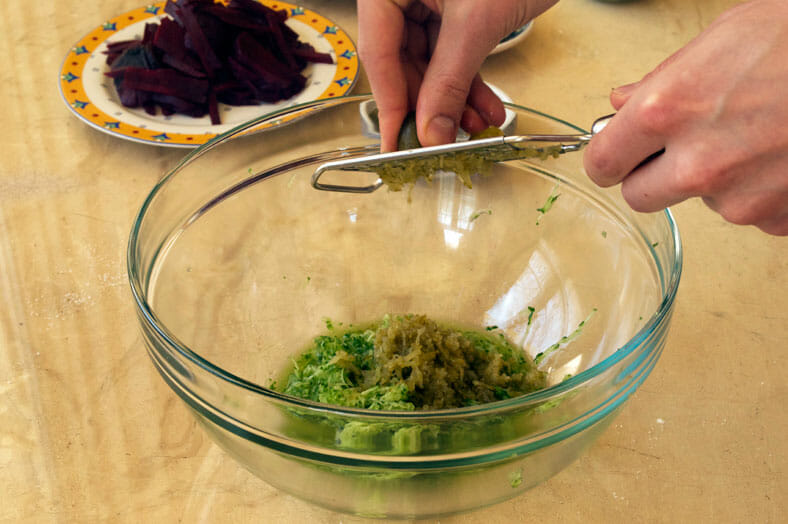

Next comes the real start of the show: kefyras, or kefir. Kefir is a fermented enzyme-rich cultured beverage that originates from the Caucasus Mountains. Sometimes affectionately called the “Drink of the Prophet (Muhammad)” in Muslim Caucasian communities, kefir is jam-packed with beneficial micro-organisms, macronutrients and vitamins and minerals. While indeed a yogurt relative, kefir itself is slightly different in that it contains additional strains of beneficial bacteria and is mesophilic, meaning the bacteria thrive in cooler and room temperatures.
For saltibarsciai, you simply add the kefir over your beets and pickles. As you stir everything through, the originally white kefir will begin to take on a delightful pinkish or purple coloring depending on how much beet juice you have added.
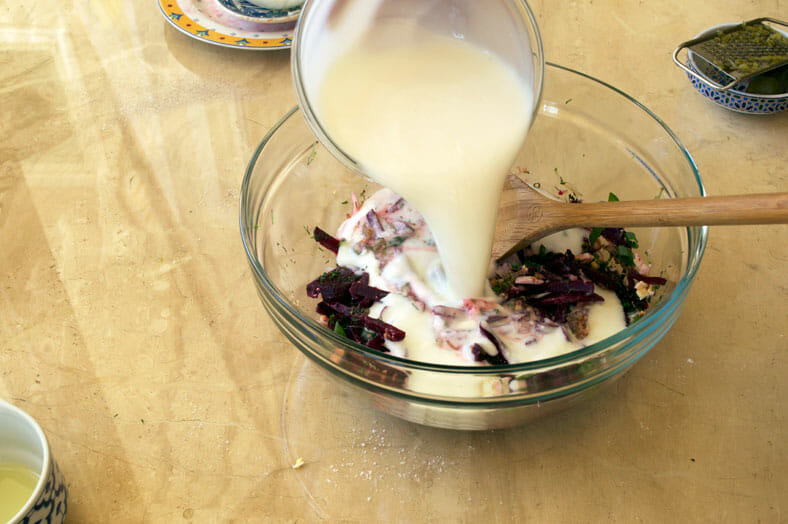
Finally, you’ll want to add your aromatic ingredients. In general, the most prominent herb in Lithuanian cuisine is dill, which most would contend should certainly be added to your saltibarsciai. After another good stir, you let it cool in the fridge until it comes time to serve, and then it’s time to enjoy!
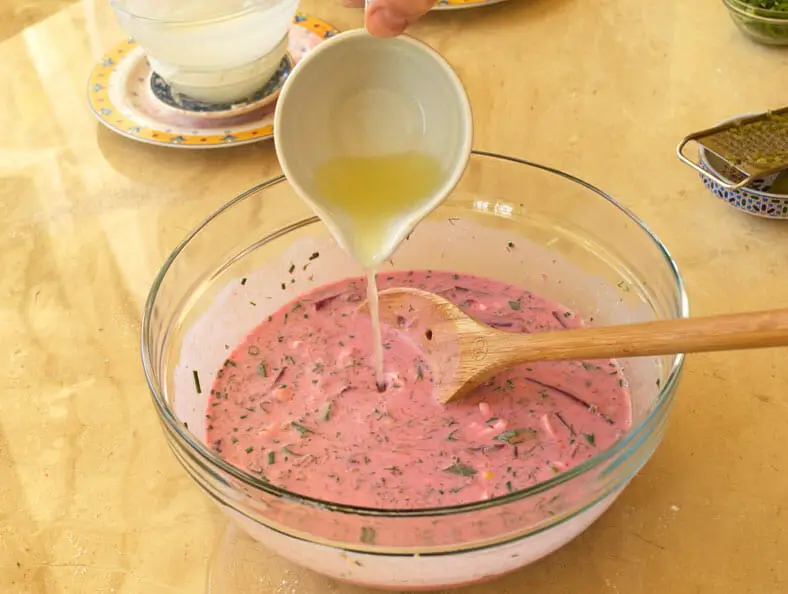
Our Take on the Recipe
When trying to make saltibarsciai, we had some immense troubles sourcing both raw beetroot and high-quality (non-processed) kefir. Interestingly, our original reference recipe warned us this might happen to people outside of Lithuania.
Alas, we made it with the best we could. For the beets, we found some stellar looking pre-cooked beets that had been vacuum sealed, so we went with those. If you were to make this beet soup for your own, we’d actually recommend going the pre-cooked route as well as it does cut down total preparation time pretty significantly.
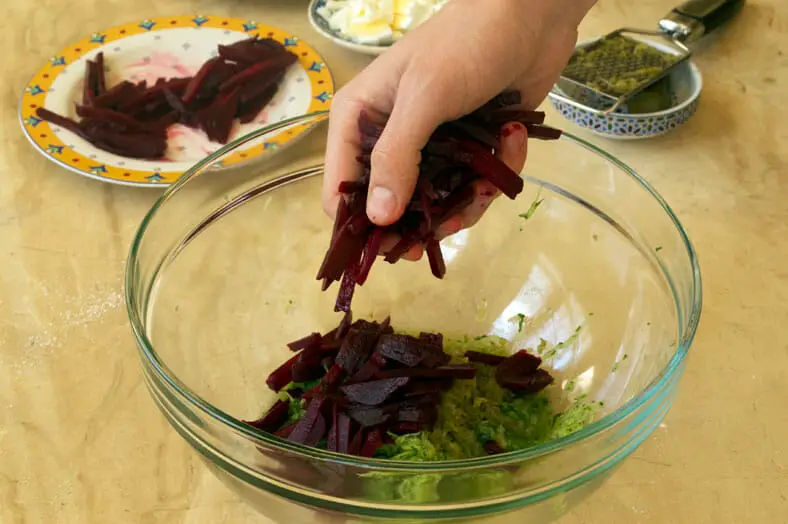
To recreate the kefir, we tried a combination of Greek yogurt and buttermilk. We didn’t realize how much of a trouble it would really be to find truly quality kefir. Granted, there are brands of kefir in the stores around us, but none of them seemed remotely close to this highly nutritious super drink. Maybe it was all the additives that tipped us off.
In the beet soup itself, we added chives, spring onions and fresh cucumbers to add additional flavors. Technically, neither ingredient are very traditional to saltibarsciai, but they really did give the dish something extra.
Also, taking on the recommendation of our source recipe, we did add a touch of lemon juice to our version of saltibarsciai as well. We were pre-warned that this too was not a traditional ingredient, but the acidity did a lovely job brighten up the taste.
Other than that, saltibarsciai was a delightful beet soup to try and certainly one to keep in the back pocket as the days get warmer!
Have you tried saltibarsciai before? Or any other beet soup for that matter? Comment below!


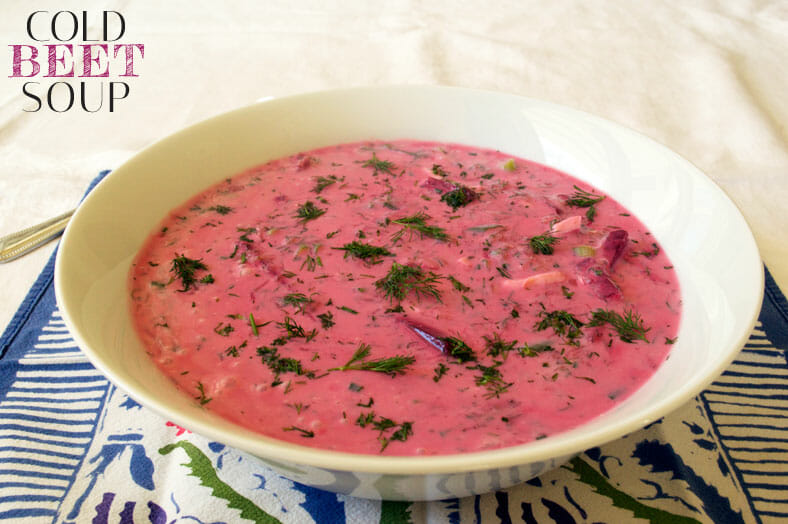
Heather, this is like a pimped up Borsht! much better looking too because I hated borsht as a kid 😉 It looks so creamy! Yum!
A pimped up Borsht it totally is, Arman! 🙂
I love that color and I can finish that entire bowl for sure! Looks like a perfect summer soup!
Indeed it is, Manila Spoon! 🙂
This soup looks fantastic and this post was FULL of awesome information. Thanks!
Thanks, Elena! Glad you liked both soup and info 🙂
I love borscht – the beet soup typical among Eastern European Jews and this sounds like a slightly more acidic version. We make ours with a dollop of sour cream, rather than kefir but the ultimate result is similar, except ours doesn’t have the pickling. As always, your ethnography and food history are stellar.
Thank you Laura! And you’re right re: acidity and pickling. It’s the slight difference that distinguishes saltibarsciai from borscht, but it’s an important one